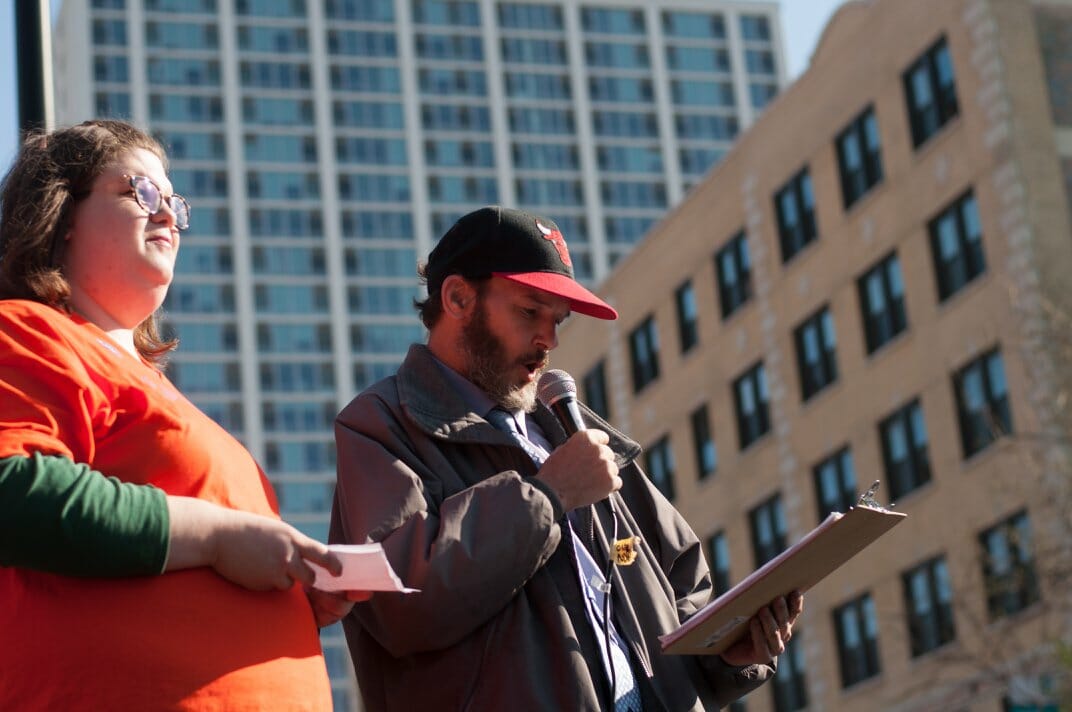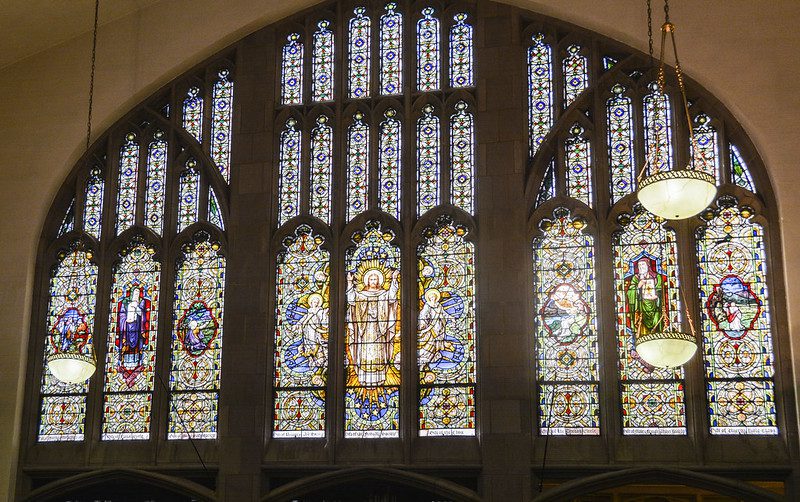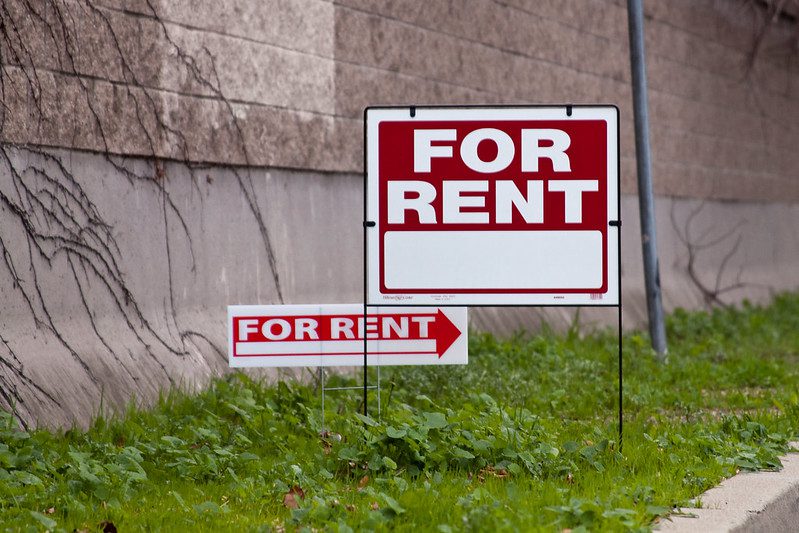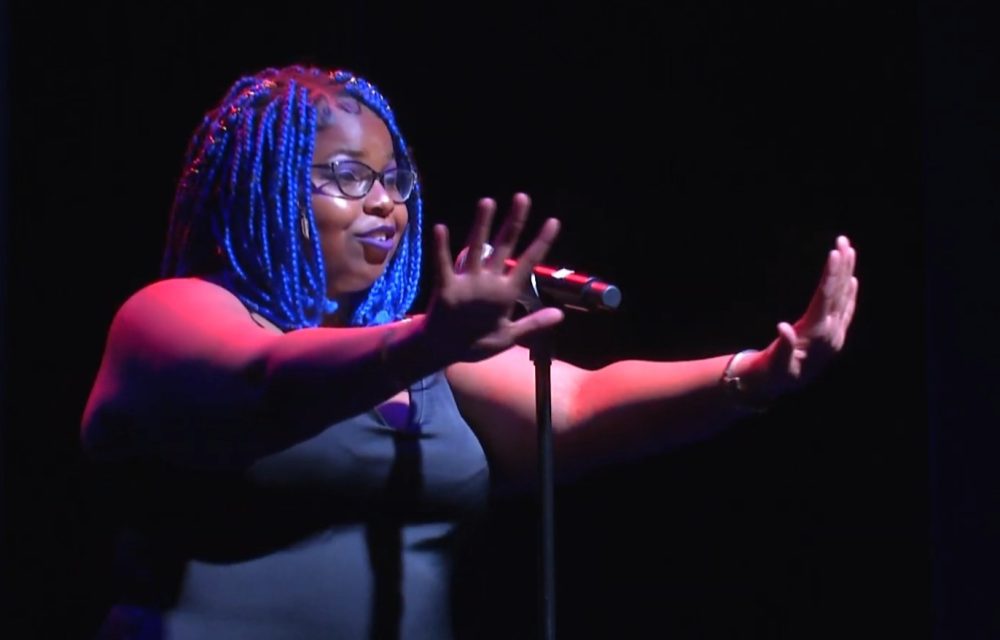Standing on a truck in front of a group of several hundred protesters, Tom Gordon expressed a feeling shared often at the ONE Northside Convention in early May: city residents know what their communities need. Gordon, who’s stayed in Chicago’s Uptown neighborhood for over 13 years and has been homeless thanks in part to the eviction of affordable single-room occupancy housing residents, continues to fight alongside his neighbors demanding more for the community.
“We march, we shut down streets, we pack courtrooms, and take over headlines,” Gordon said. “We keep doing it as long as we need to. But we shouldn’t have to move heaven and earth like this to decide what happens in our neighborhoods.”
As the convention’s theme, “Community Power, Community Solutions,” suggests, residents organizing in their neighborhoods have developed their own policy solutions that they believe will solve serious issues in their city, including police violence and skyrocketing rents. “That ain’t right,” more than 800 audience members shouted all afternoon, as volunteer leaders shared their experiences from seeing cuts to necessary resources, such as public education, Medicaid, and senior housing.
The convention reflected ONE Northside’s insistence that neighborhood leaders have a seat at the table as developers change the area’s makeup. After years of decline and disinvestment across Chicago, that mission takes on extra meaning today, as gentrification turns communities that were once accessible to the poor into increasingly pricey domains. Yet the mission of the convention has shifted dramatically in just a few years: residents no longer need local leaders to bring in scarce city resources for new growth in their neighborhoods, but are instead fighting for citywide measures that would foster community power in ways unavailable to residents today.
Two years before that (conventions are now held biannually), pressure applied at the convention helped lead to the passage of a Single-Room Occupancy (SRO) Ordinance, which prevented developers from flipping SROs into market-rate housing without preserving at least 80 percent affordability.
By bringing a number of elected officials face-to-face with a loud and rambunctious crowd, organizers hope their message will be heard: concerned citizens are ready to hold politicians accountable if they ignore their demands. Throughout the event, alderman and state elected officials were asked to express their support for a number of ongoing campaigns being carried out by the organization. When 44th Ward Alderman Tom Tunney refused to fully endorse a demand that new developments hire area residents, the lone dissenting statement all day, the audience rained down boos and began chanting, “We remember, we vote.” Tunney will be up for re-election next year.
Yet the question remains: when the time comes, will elected officials remember their promises, and will the people hold them accountable if they forget? Can ONE Northside continue to organize and ensure that the community has its say, as it has for decades, and can the organization broaden the struggle to unite with other groups in the city?
Fighting for Stronger Community Benefits
One key campaign highlighted at this year’s convention speaks to the changing circumstances the community group faces today. That’s the issue of citywide Community Benefits Agreement (CBA) campaigns, which the group has been developing in coalition with other neighborhood groups over the past few months. CBAs are legally enforced contracts negotiated by community groups, elected officials, and developers to ensure that local residents receive important benefits from a potential development in their community. Such agreements can include agreed-upon amenities like living-wage jobs for local residents, support for local schools, and measures that would preserve affordable housing, particularly in any housing-related construction.
For the past several years, ONE Northside has fought for individual CBAs with a number of developers, to mixed results. City developers are frequent donors to Mayor Rahm Emanuel, as well as to individual alderman who control zoning permits in their wards, clear conflicts of interest that ONE Northside often documents. In the case of 3901 North Broadway, which was targeted by protesters at the end of the convention, Alderman James Cappelman received $10,000 from FOG Capital, the company that purchased the development several years ago before flipping it. By strengthening CBA standards for affordable housing and living-wage jobs across the city, which would commit developers to work with community members before proceeding with any development, organizers hope they won’t have to run from development to development, fighting for small changes while their city is transformed.
“The CBA [campaign] aims to give power back to the people,” says Michael Cuaresma, who’s organizing with the CBA committee. “It’s very difficult to tackle each development as an individual entity, when the entire system doesn’t make sense.”
Taking a bigger-picture approach is particularly important in the wake of the announcement of the Obama Presidential Center, a 19-acre complex that is set to begin construction later this year in the Woodlawn neighborhood on the city’s South Side. In that community, some of the CBA demands are quite different from the more-resourced North Side: organizers are calling for the agreement to ensure that all public schools within a five-mile radius have a full-time librarian, for example. But the basic principle stays the same across the city: residents must have a say in what and how things are built in their backyards, particularly when those changes could entail dramatic displacement (around the Obama Presidential Center, for example, rents have already jumped by several hundred dollars).
“For a citywide CBA [measures] to happen, you’re going to need community leaders from everywhere in Chicago to agree on similar demands,” Cuaresma says. “Not only do we have to negotiate with the alderman and pressure them, but we have to negotiate with ourselves and realize that Chicago is bigger than the North Side, it’s bigger than the South Side.”
Creating the coalition around citywide community benefit measures is an ongoing process, as individual community groups continue to fight for individual CBAs, such as the ongoing Obama Center agreement, even as they take aim at a strong citywide mechanism. The organization is currently collaborating with the Chicago Housing Initiative to strengthen affordable housing requirements, and with the Grassroots Collaborative, a collection of 11 membership-based organizations, to strengthen the demand for living wages.
Before the convention, ONE Northside members who were working on the CBA committee had to decide whether to demand aldermanic support for stronger citywide mechanisms or for specific CBA agreements in Uptown, given the limited time they had during the event. Choosing to emphasize the citywide measure speaks to the organization’s commitment to structural change, and a recognition that these issues extend far beyond neighborhood boundaries.
“We’re trying to tackle these things individually while also creating something holistically that tackles the problem in a more well-rounded way,” Cuaresma adds.
Interracial Coalition Building in Chicago
ONE Northside is a community organization based in Chicago’s Uptown, Lakeview, and Edgewater neighborhoods. The organization is the result of a 2013 merger between the Organization of the Northeast (ONE) and the Lakeview Action Coalition (LAC), a decision that Executive Director Jennifer Ritter says was made “because we needed to be bigger and have more power to push back.” The conventions have been an important tool for the organization since its creation in 1974, when organizers used the event to build power and create accountability for elected officials.
When ONE was founded, the Uptown neighborhood it called home was one of the poorest communities on the city’s North Side. According to Jennifer Frost’s book, An Interracial Movement for the Poor, New Left organizers conducting an informal survey in the community in the late ’60s found that nearly half the population in one five-block area was unemployed, with one-third receiving government assistance. Uptown residents were largely poor whites, many coming from rural Appalachia. Still, the growing presence of Black and Latino families in the 1970s made the area fertile territory for interracial organizing. The original Rainbow Coalition—founded by Chicago Black Panther leader Fred Hampton—united the Black Panther Party, the Puerto Rican Young Lords, and the Poor White Young Patriots Organization, which were based in the neighborhood, suggested an organizing strategy that sought to tie together the disparate struggles poor residents faced in their city.
Of course, balancing the needs of people in one neighborhood with the ability to fight for changes that can impact the wider landscape is an ongoing challenge for all community organizations. Ritter believes that coalitional work is integral to the organization’s strength. She suggests that the organization and its members understand the interconnections running through their work, recognition that is integrated into their organizing strategy as they fight for community power.
“Everything that happens in Chicago impacts our community,” she says. “So we’re not going to create a housing strategy that hurts another neighborhood. The other side wants us to be fighting over a continually shrinking pie, and we’re just not going to do that. [So] whenever we can, we coalition.”
After years of relative economic stability, the city itself is at somewhat of a crossroads. Research from the University of Illinois-Chicago’s Voorhees Center recently found that the city’s demographics are growing increasingly polarized, leading to school and mental health facility closures in poor neighborhoods and displacement in increasingly wealthy areas. Both the number of very wealthy (greater than 140 percent of area median income, or AMI) and very poor (less than 60 percent of AMI) census tracts have tripled in the past 40 years, while the number housing middle-income residents (those between 80 and 120 percent AMI) has fallen from 45 percent of the city to just 16 percent today. Since 2000, more than 250,000 Black residents have left the city, many of them middle income, further entrenching the racial and economic disparities that come from the city’s brutal history of spatial inequality and segregation.
In that landscape, where growing impoverishment runs parallel to increasingly obvious displays of wealth, community organizations like ONE Northside are using interracial, cross-city coalitions, battling for Chicago-wide measures that recognize that all poor residents, whether they’re living in disinvested neighborhoods or are being pushed out of rapidly gentrifying areas, need something different from their city. ONE Northside has been involved in that shift, highlighting several campaigns at the convention that are the product of collaborations with other community groups. This includes Lift the Ban, an ongoing push for rent control to be enacted in Illinois, as well as the Grassroots Alliance for Police Accountability, which would improve police practices and accountability.
Just like the coalitions that hope to make structural change on a wider level, ONE Northside uses its convention to show how so many of these issues are connected. Organization leaders see the convention serving several overlapping purposes: getting upwards of 60 convention-planning volunteers to become key members of the organization, amplifying ongoing campaigns and pushing them to new levels, and linking the community’s many political struggles within a common framework.
“Often, the issue work happens in necessary silos, and the convention is a moment to just completely remove the silos and say, ‘What’s the story of what we’re doing here?’” Ritter says.
As they continue to fight for structural change, the organization and others like it will succeed as they learn to work through the structural barriers that come to split the city itself. For one, Chicago’s ward system allocates incredible power to each alderman to decide what happens in their communities, an issue exacerbated by the sheer number of elected officials in the city. With 50 alderman for the entire city (by comparison, Los Angeles and Philadelphia each have 15 citywide representatives), the impulse to fracture into shrinking interest groups, concerned primarily with solving issues in one’s own backyard, is quite strong. While ONE Northside volunteers show that they have their own ideas for how to run their neighborhood, the organization will continue to contend with a city that makes systemic change as difficult as it is necessary.
“The city itself was designed to separate us and keep us in our little communities, and stopping us from understanding that we’re dealing with very similar issues,” said Cuaresma of the CBA committee. “It’s about finding the commonalities within each community, that’s going to be the key to getting these things passed.”






Comments